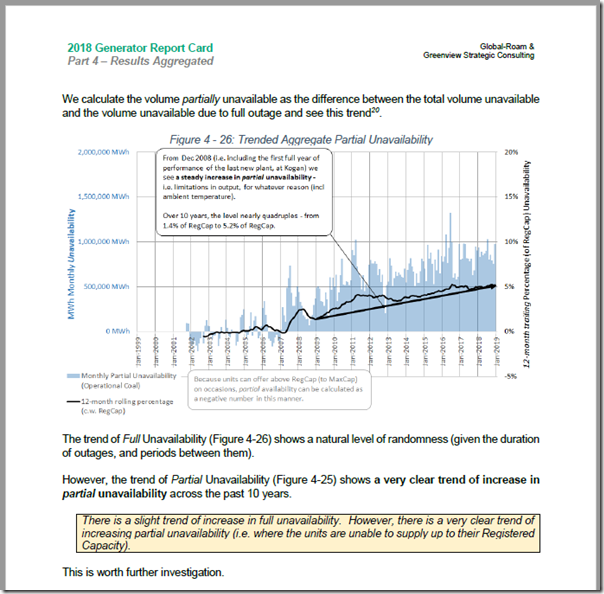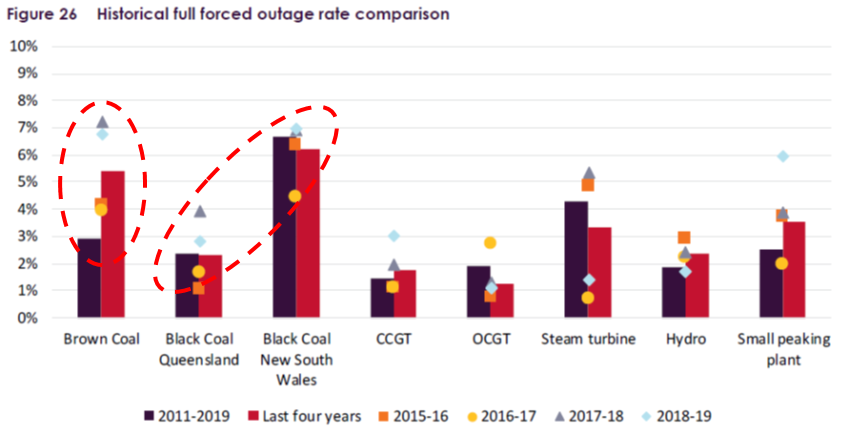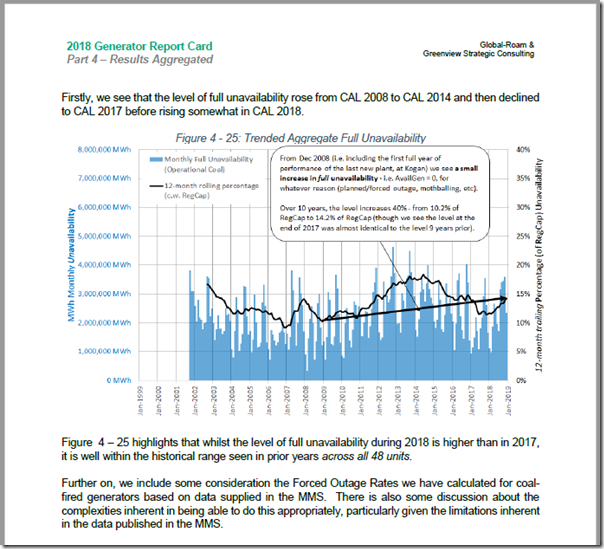… and so with this refresher to probability, consequence, and risk behind us, let us continue on with today’s brief two-part article, let’s take a look at concerns for the fast-approaching summer 2019-20.
—-
Following Allan’s earlier casino analogy, three days later (on Monday 26th August) guest author Allan O’Neil continued with this excellent unpacking of what was noted in AEMO’s 2019 publication of the ESOO on Monday 26th August.
The 2019 Electricity Statement of Opportunities itself is here, for ease of reference.
We’re three months closer to summer, now – and we’ve noticed an uptick in news media coverage* of looming risks over summer like this one “Precarious power grid faces serious risks, warns Energy Minister Angus Taylor” on 4th November by Perry Williams in the Australian and the article “Victoria manufacturers prepare for power crunch” by Angela and Mark in the AFR yesterday.
* unfortunately this news media coverage is stoked by people playing partisan politics – which seems par for the course these days, but which probably makes it more difficult for an objective observer to truly understand the real risk we’re facing.
This lead-in line from the weekend’s AFR article seems to sum up the concern:
“Manufacturers are drawing up contingency plans to shift operations out of Victoria this summer as fears of blackouts and sky-high electricity prices for the March quarter keep nerves on edge.”
It’s worthwhile to revisit the three separate concepts to understand how each applies in terms of the risk of supply/demand balance being stretched.
B1) Probability of a particular unit outage
Remembering that probability is the chance of a particular event happening, let’s talk about this in terms of electricity supply sector concepts:
B1a) Availability of a unit
Availability is a volumetric measure (i.e. focused on MWh available to dispatch into the market, as distinct from instantaneous MW rate) that might be expressed in MWh or as a % of a total hypothetical volume over some time. range
How it’s calculated is different for Scheduled, Semi-Scheduled and Non-Scheduled units:
(i) For Scheduled units it’s relatively easy matter of calculating based on the availability in the bid for the unit – for each dispatch interval – and then aggregated over the time-range of interest.
(ii) For Semi-Scheduled units, it’s a little more complex – because the bidding process is different for these projects:
1. The availability estimate in ASEFS or AWEFS (or the self-forecast) overwrites the “Max Avail” in the bid to define what NEMDE actually sees as the capability of the unit.
2. Hence this must be used to cap the volume in each bid band to define the true bid structure for the unit for a dispatch interval – and then aggregate over time as above.
(iii) For Non-Scheduled units it is impossible to calculate availability, as all we can see is the output of the unit (assuming this is even provided in “Initial MW”). Historically that’s not been an issue – but will it start becoming an issue in future?
In this article on 14th June I unpicked some of the work that we had done in the Generator Report Card 2018 to trend the aggregate level of unavailability across the remaining 48 coal-fired units in the NEM. In this case, we calculated unavailability as:
Unavailability = Theoretical Perfect Availability (based on Registered* Capacity) – Actual Availability (in the coal generator bids)
* in this case we used Registered Capacity to set the upper bound because of how that relates to a most coal plant’s “normal” operating range (i.e. below overload).
What’s particularly interesting is that unbundling this unavailability into sub-categories of “full” and “partial” show that:
(i) Aggregated across all 48 coal units, full unavailability in has largely remained the same over the 10 years to 31st December 2018 (see chart copied further below); whereas
(ii) There has been a consistent trend up of partial unavailability – again aggregated across all 48 x operational coal units, as shown in the prior article, and copied in here for convenience:
With respect to concerns about Victoria and the coming summer, it’s worth remembering that Victoria (now, after Hazelwood closure) has 10 x operational coal units – so only 10 out of the 48 units used in total for the aggregations in the Generator Report Card.
Readers might like to keep that in mind in contemplating the specific implications for Victoria. Unit level data for all 10 of these Victorian coal units (along with the other 320 units across the NEM that have operated in recent times) were individually detailed in the Generator Report Card 2018, with updated (and extended) statistics to be prepared for our Generator Statistical Digest 2019 for release in January 2020.
B1b) Forced outage rate for a unit
Whilst availability is a measure of the probability of a MWh of energy being available at any given time over a period, there’s also a concern about the risk of a generator being unavailable at a critical time – and, more specifically, tripping at a critical time.
This requires different metrics than blanket availability, with some of what we did under a ‘Sudden Failure’ category in the Generator Report Card discussed here.
Statistically speaking, the volume of energy capability that a generator might typically lose from ‘forced’ outages would typically be significantly lower than the volume of energy capability lost from ‘planned’ outages (i.e. the probability is lower). However the consequence of such events might be significantly higher, as they could occur unexpectedly, and at inopportune times.
In Allan article ‘ESOO Unboxing’ from 26th August 2019 he notes that the diagram in the ESOO that best summarises Full Forced Outage Rates was this one:
Allan noted that two key observations from this data that resonated with him were:
(i) brown coal plant forced outage rates had risen over the past four years with the last two years being particularly poor; and
(ii) while there’s no obvious time trend over recent years, there’s a very big discrepancy between black coal plant forced outage rates on different sides of the NSW-Queensland border.
Currently calculating forced outage rates is something that’s not at all easy for anyone to do, other than AEMO (we did have a go, in the Generator Report Card), because some of the data required to do this properly is currently deemed confidential for all time.
(i) Being forced to rely on just a single organisation (any organisation!) for detailed analysis of raw data is not an ideal solution – especially one that is so complex, and also so fundamental to modelled results such as in the ESOO.
(ii) That’s one reason why we’re particularly keen for this rule change proposed by ERM Power to be accepted by the AEMC.
B1c) … but no, higher ambient temperatures do not increase the probability of a particular coal unit outage
Whilst focusing on the overlapping topics of probability, summer and coal, it is worth stating directly that none of the data we pored through as in the process of preparing the Generator Report Card 2018 suggests that the probability of a coal unit outage is higher in summer (in fact, the you can see here that the monthly full unavailability is typically lower during the hotter months – which makes sense, as that’s obviously when the market needs it most):
Yes, high ambient temperatures do have an effect on limiting the maximum output capability of coal units, though:
(i) The effect is different for different units; and
(ii) The effect is probably far less than you might have been led to believe had you been reading less numerically-based commentary elsewhere.
(iii) This is one of the reasons for the shape in the partial unavailability trend in the 1st chart above.
In the Generator Report Card 2018 , we investigate temperature effects on peak output across all types of generation assets and include some results that might surprise some readers (including how some wind farms demonstrate output capability limitations at high temperatures – some quite pronounced).
For our Generator Statistical Digest 2019 we are scoping out how we can extend this analysis into more depth for every single DUID for results shown through CAL 2019, as this type of objective data is going to be much more important into the future.
B2) Consequence, if that same event does happen
Now with concerns for heightened level of risk in the Victorian region for this coming summer period (quite understandable concerns) I can understand a sense of cognitive dissonance emanating from those for whom the data above is a revelation. They might be saying:
How can it be that the coal units are typically more available during summer, and no more likely to trip due to heat – and yet we face increased risk?
This is where I would point again to our reminder about the two key aspects of risk and note that we have not spoken about Consequence – which is (I believe) the forgotten part of the equation, and where the answer to our rhetorical question lies.
Up until the closure of Hazelwood, the Victorian region had 18 coal units at its disposal – now it only has 10. Assuming all else is equal* then hopefully readers can understand that the consequence of any given unit being unavailable is so much greater, as there are many fewer units to draw upon should that unit be unavailable, for whatever reason.
* note that it’s not strictly true that “all else is equal” as there have been a number of overlapping developments in the Victorian region since that time – but it’s not a bad simplifying assumption to start with
Returning to our clapped out 2nd car analogy, Victorians have (for years) received the benefits of having that second car in the garage, in the form of Hazelwood. Might have been very old, and a bit of a pain to run (and very bad for emissions!), but it was there as a back-up if the first car was at the mechanics for some reason.
These days (post Hazelwood, and with almost NIL new dispatchable capacity built as replacement in VIC) it’s a more white-knuckle ride on the Victorian roads these days, with no back-up car (maybe no spare tyres, either) to call on should our primary workhorse have to be in the workshop for any reason.
B3) So let’s focus on solving the ‘real’ problems
It’s because of heightened consequence, not (primarily*) because of heightened probability, that we’re sweating so much on concerns about whether Loy Yang A3 will be back in time, and the same for Mortlake Unit 2!
* though the concerns about increased forced outage rates on the dwindling number of thermal “workhorse” units is one that should be taken seriously – and I look forward to the AEMC approving ERM Power’s rule change request (draft determination published on 24th Oct with comments due 9th Jan 2020 and expected completion 20th Feb 2020) so we can all understand more clearly how significantly this is changing.
I well understand that there are a number of valid reasons why a growing number of people dislike generation from coal-fired power (primarily related to carbon emissions, but also particulates and so on), but this does not mean that they should be misrepresenting what the data is actually saying, in terms of risks to reliability for the coming summer period and into the future.
As noted in our Generator Report Card 2018, the current coal-fired fleet will close in the years ahead – and it would seem crazy to build replacement dispatchable capacity using coal as a fuel (doubly crazy to build anything large in northern Queensland given local issues there, and the fact that it’s Victoria – and then NSW – which will be screaming out for new capacity).
However, if we start with an incorrect understanding of what the actual problem is, then it’s a very low chance we’ll ever come up with a solution that actually works?
That’s surely not what we had in mind in writing that our “transitional challenges require greatly enhanced analytical capability” under Theme 2 in Part 3 of our Generator Report Card 2018:
We need to do better than that – and it would be a great start to remember the difference between probability and consequence (and how both relate to risk, as summer washes over us).
B4) Stay tuned for updates as summer progresses…
Guest author, Allan O’Neil, will be back through summer 2019-20 to add in some detailed analysis and commentary should the supply/demand balance become too overheated.
Whilst many readers have noted that Allan does a wonderful job of explaining complex events (thanks!), I’d also believe that many of us are hoping that Allan does not find much to write about this time!
However we need to be realistic that (even just because of heightened consequence, if a dispatchable unit should be offline unexpectedly) the level of risk this summer is heightened, especially for Victoria.





![2018GeneratorReportCard-Part2-Theme1[1] 2018GeneratorReportCard-Part2-Theme1[1]](https://wattclarity.com.au/wp-content/uploads/2019/11/2018GeneratorReportCard-Part2-Theme11.png)
“if we start with an incorrect understanding of what the actual problem is, then it’s a very low chance we’ll ever come up with a solution that actually works?”
Without level playing field power generation I’d suggest the big picture can never work. That simply means every tenderer of electrons to the communal grid must reasonably guarantee them (ie short of unforeseen mechanical breakdown) along with a minm FCAS standard 24/7/365 or keep them. The fact we don’t demand that is the root cause of all the problems we currently face.
It’s a political problem and not an engineering/ economic one even if you want to levy a level playing field CO2 tax on them all which is further compounded politically with the international cooperation required. Nothing like protracted brownouts to call forth the political will nationally to face the truth at some stage I suppose while the international politics is a second order priority.